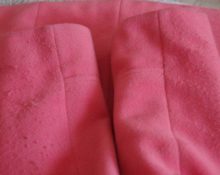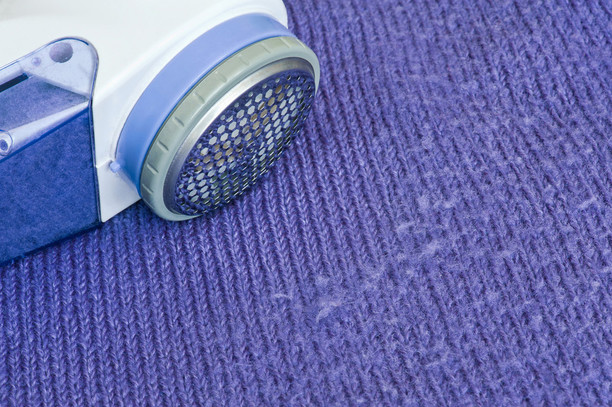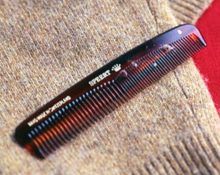Sooner or later, pills will definitely appear on your sweater, and the earliest they form is on the sleeves. Then the unwanted formations cover the entire surface of the clothing. As a result, the item begins to look shabby and worn out.
How to properly remove pellets?
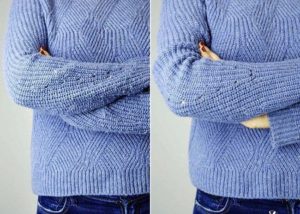 The secret to success is the correct application of cleaning techniques. It is necessary to move not only from top to bottom, but also in the opposite direction. However, you should not move your hand from side to side. Also, don't start the problem. It is worth getting rid of matted lumps as they form. This is a much more aesthetic and practical approach to the issue.
The secret to success is the correct application of cleaning techniques. It is necessary to move not only from top to bottom, but also in the opposite direction. However, you should not move your hand from side to side. Also, don't start the problem. It is worth getting rid of matted lumps as they form. This is a much more aesthetic and practical approach to the issue.
A little about the reasons for their appearance
In most cases, what happens can be explained in 2 ways.
- Low quality fabric. If the material is not resistant to wear, then matted balls will constantly form on it, which are essentially signs of a violation of the integrity of the fibers.
- Ignoring the rules for caring for a specific item.Most often, washing instructions are violated. Moreover, you need to follow not only the advice given by the manufacturer on the label, but also be able to sort things.
The way you wear it also matters. Thus, knitted and velor trousers are often frayed and covered with pills in the places where the thighs touch, and sweaters - in the armpits and on the sleeves. Slender women are less likely to encounter the first situation. Fat ladies need to either come to terms with the inevitability of the phenomenon, or stop buying pants made of polyester, viscose and elastane. In the case of sweaters, you should read the composition more carefully. Models sewn from both artificial and natural fibers are most prone to pilling.
6 ways to get rid of pellets
Ideally, you should either entrust the job to dry cleaning employees, or transfer the item to “household” status. If neither option is suitable, you can try to remove the problem yourself using folk recipes and scientific achievements.
Method one: using a specialized machine
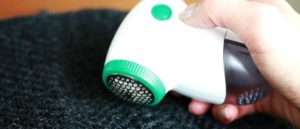 A compact device that runs on AA batteries or a battery will help restore the smoothness of knitted and woolen items. Such devices do the worst job of removing matted lint on an angora.. Most of these devices weigh very little, less than 200 grams. Heavier models with a built-in battery that can be charged from the mains. It is usually more difficult to treat clothes with them due to their weight. However, this disadvantage is offset by the wide working surface.
A compact device that runs on AA batteries or a battery will help restore the smoothness of knitted and woolen items. Such devices do the worst job of removing matted lint on an angora.. Most of these devices weigh very little, less than 200 grams. Heavier models with a built-in battery that can be charged from the mains. It is usually more difficult to treat clothes with them due to their weight. However, this disadvantage is offset by the wide working surface.
You don't have to pay much for such a machine. Budget models that are sold in regular sales stores cost even less.However, in this particular case there is no need to save - the item is in the wrong price category. It’s better to pay some 50–200 rubles more, but get a device with normal knives.
To eliminate the defect, just turn on the machine and apply its working surface to the area with the pellets. Built-in tiny knives will cut off the lint that has bunched up and redirect it into the removable container of the machine. Good fabric will not be affected. The protective mesh will prevent this from happening.
Method two: treatment with a disposable razor
 Not the most accurate option, but you can resort to it if you need quick results. All you need is an old machine (no rust). Move it along the problem area along the direction of the grain. Avoid jerky movements.
Not the most accurate option, but you can resort to it if you need quick results. All you need is an old machine (no rust). Move it along the problem area along the direction of the grain. Avoid jerky movements.
Method Three: Using Sticky Objects
Questionable approach to solving the problem:
 suitable only for sweaters that are not prone to frizz;
suitable only for sweaters that are not prone to frizz;- is not effective: it can only clean easily separated formations and small debris;
- can speed up the wear process.
The essence of the technique comes down to gluing tape to the area covered with pellets. Then it is torn off with a sharp movement. Some lint and lumps remain on the adhesive side. The same principle works with a clothes dryer roller. Press the adhesive part onto the sweater and quickly move your hand away. If the pellets have formed recently, they will come off.
Method four: mechanical
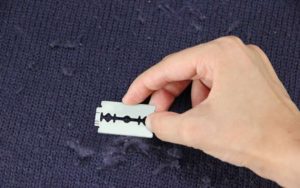 It's worth trying manual cleaning. Simply cut off formations that are difficult to yield with scissors or a blade. Careful housewives can also resort to a straight razor. Just be sure to stretch the sweater before you touch the surface with the blade.
It's worth trying manual cleaning. Simply cut off formations that are difficult to yield with scissors or a blade. Careful housewives can also resort to a straight razor. Just be sure to stretch the sweater before you touch the surface with the blade.
To make the process easier, comb the jacket with a very fine comb before you start removing pellets.
Method five: using hygiene items
 Another variation of combing. Take a toothbrush with stiff bristles. Move it along the fibers until the excess pellets fall off. After the procedure, soak your favorite sweater in a bowl of vinegar and warm water. Some people use pumice instead of a brush. The result of their use is approximately the same: the wardrobe item begins to fluff more, and the matted lumps only partially fall off.
Another variation of combing. Take a toothbrush with stiff bristles. Move it along the fibers until the excess pellets fall off. After the procedure, soak your favorite sweater in a bowl of vinegar and warm water. Some people use pumice instead of a brush. The result of their use is approximately the same: the wardrobe item begins to fluff more, and the matted lumps only partially fall off.
Method six: treatment with breadcrumbs
The property of folk wisdom. This is what our mothers did. If they needed to eliminate matted lint, they took a piece of stale bread and rubbed it over their clothes. Crumbs will fall off the cracker. Don't stop when you see them, this is the "tool" for cleaning. The crumbs will cling to the pellets, the owner will only have to “comb” them both out with her palm.
What to pay attention to when processing?
It is necessary to consider and check:
 pile direction;
pile direction;- what does the fabric look like after removing the pellet from it;
- Did any holes appear after removal?
All these points will be easy to notice if you spread the sweater on a hard surface. For example, on an ironing board or a craft table. The procedure for removing pellets is not carried out “by hand”.
When choosing a machine, you should consider:
- container volume;
- battery charging time (for some it lasts 6-8 hours);
- mobility and flexibility of the working surface (besides, it should not be very fragile).
What can I do to prevent them from appearing?
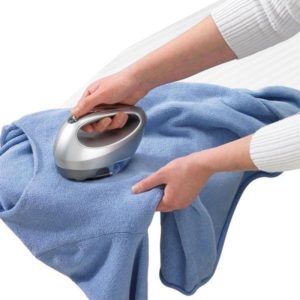 You should follow the recommendations that manufacturers indicate on sweater labels. It is important to observe the temperature regime for washing and drying.Also, do not forget to consider whether a particular item of clothing can be ironed and where it needs to be stored. We also need to reconsider the way we sort dirty things. Do not place clothes made from coarse and light fabrics into the machine drum at the same time.
You should follow the recommendations that manufacturers indicate on sweater labels. It is important to observe the temperature regime for washing and drying.Also, do not forget to consider whether a particular item of clothing can be ironed and where it needs to be stored. We also need to reconsider the way we sort dirty things. Do not place clothes made from coarse and light fabrics into the machine drum at the same time.
If the product has steel inserts or metal dogs, then sweaters that require delicate handling cannot be washed with it. And don’t skimp on washing powders and fabric softeners. Use only products that are suitable for sweaters.
Don't neglect fiber softening liquids. Due to them, the jacket will retain its shape and attractive appearance longer.
Ideally, complex stains and frequent washing should be avoided. If the stain is difficult to remove, you should go to dry cleaning rather than subjecting the item to prolonged soaking and preliminary cleaning.


 suitable only for sweaters that are not prone to frizz;
suitable only for sweaters that are not prone to frizz;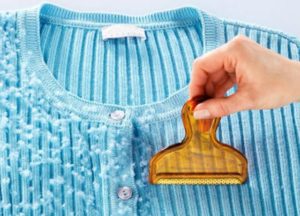 pile direction;
pile direction; 0
0